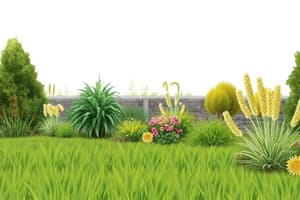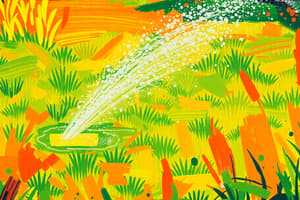Podcast
Questions and Answers
A plugger is used to help nutrients penetrate deeper into the soil.
A plugger is used to help nutrients penetrate deeper into the soil.
True (A)
Grass seed should be spread unevenly and buried deep in the soil for best results.
Grass seed should be spread unevenly and buried deep in the soil for best results.
False (B)
Common Bermudagrass should be mowed at a height of 1 to 2 inches.
Common Bermudagrass should be mowed at a height of 1 to 2 inches.
False (B)
Keeping the area consistently moist is important until the new grass establishes.
Keeping the area consistently moist is important until the new grass establishes.
Fescue grass is recommended to be mowed at a height of 2 to 3 inches.
Fescue grass is recommended to be mowed at a height of 2 to 3 inches.
The best time to repair your lawn is during the summer when temperatures are cooler.
The best time to repair your lawn is during the summer when temperatures are cooler.
Sodding is an ideal method for larger bare areas that require a quick transformation.
Sodding is an ideal method for larger bare areas that require a quick transformation.
Watering newly planted grass is unnecessary if consistent rainfall occurs.
Watering newly planted grass is unnecessary if consistent rainfall occurs.
Core aeration helps improve soil drainage and reduce lawn diseases.
Core aeration helps improve soil drainage and reduce lawn diseases.
Proper fertilization supports seed growth and is not necessary for successful lawn repair.
Proper fertilization supports seed growth and is not necessary for successful lawn repair.
Plugging involves the use of pre-grown grass patches taken from healthy areas of the lawn.
Plugging involves the use of pre-grown grass patches taken from healthy areas of the lawn.
Keeping sod moist after laying it down is essential for establishment.
Keeping sod moist after laying it down is essential for establishment.
Weed competition is typically higher in spring compared to other seasons.
Weed competition is typically higher in spring compared to other seasons.
Flashcards
Plugging
Plugging
Using a tool like a plugger or garden trowel, carefully extract healthy sections of your lawn. These plugs are then replanted into the bare or thin areas of your lawn to fill in the gaps and promote growth.
Plugging Spacing
Plugging Spacing
Spacing your plugs appropriately - 6 to 12 inches apart - ensures even coverage and allows the new grass to establish properly.
Proper Mowing
Proper Mowing
Regular mowing with a sharp blade is crucial for maintaining a healthy lawn. Avoid removing more than 1/3 of the grass blade at each mowing.
Grass Seed Selection
Grass Seed Selection
Signup and view all the flashcards
Reseeding Lawn
Reseeding Lawn
Signup and view all the flashcards
Sodding
Sodding
Signup and view all the flashcards
Optimal Time for Lawn Repair
Optimal Time for Lawn Repair
Signup and view all the flashcards
Watering for Lawn Repair
Watering for Lawn Repair
Signup and view all the flashcards
Fertilizing for Lawn Repair
Fertilizing for Lawn Repair
Signup and view all the flashcards
Core Aeration
Core Aeration
Signup and view all the flashcards
Weed Competition
Weed Competition
Signup and view all the flashcards
Grass Establishment
Grass Establishment
Signup and view all the flashcards
Study Notes
Lawn Renovation and Repair
-
Sodding: Laying pre-grown grass patches or rolls, ideal for large bare areas, quick results. Prepare soil, remove debris, lay sod tightly, ensure good soil contact, water thoroughly, keep moist until established.
-
Plugging: Planting small grass patches from healthy areas. Use a plugger or trowel to remove plugs, replant in bare areas, space plugs 6-12 inches apart, water thoroughly, keep moist until established.
-
Reseeding: Simple, cost-effective method for thin areas. Choose appropriate grass seed for region. Prepare the bare areas by raking, remove debris, spread evenly, lightly rake into soil, keep consistently moist until new grass establishes.
Tips for Lawn Repairs
-
Timing: Spring or fall for best results (milder temps, less weed competition, consistent rainfall).
-
Watering: Water daily for 15-20 minutes to keep seed moist, especially with no rainfall. Follow a strict schedule for 14-21 days post-renovation.
-
Fertilization: Proper fertilization supports seed growth using a slow-release fertilizer.
-
Core Aeration: Improve soil drainage, reduce diseases, and allow water/nutrients to penetrate deeper into soil.
-
Mowing: Maintain a regular mowing schedule with a sharp blade. Never remove more than 1/3 of the grass blade at each mowing.
Recommended Mowing Heights
- Common Bermudagrass: 3/4 to 1 1/2 inches
- Hybrid Bermudagrass: 1/2 to 1 1/2 inches
- Centipedegrass: 1 to 2 inches
- Zoysiagrass: 1 to 2 1/2 inches
- St. Augustine: 3 to 4 inches
- Fescue: 3 to 4 inches
Studying That Suits You
Use AI to generate personalized quizzes and flashcards to suit your learning preferences.




